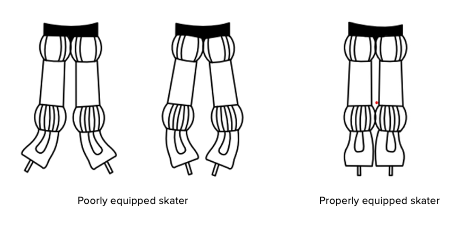Buying Skates
The first decision to be made before going to the store is what style of skates—figure or hockey—is more appropriate. If you are registering at a Preliminary, Junior, Intermediate or Senior level, figure skates are required. PreCanSkate and CanSkate skaters may wear either hockey or figure skates. Figure skates do not have much of a rocker on the blade, so beginner skaters may find them easier to learn on. If you are interested in figure skating, getting figure skates right at the beginning will speed the skater’s progress.
The most important factor is the quality and support of the boot. Skates should provide firm support around the ankles. If you are buying used skates, check for support at the ankles as this can be worn down from use or abuse. When skates are laced up snuggly, the ankles should be straight so that the skate becomes a natural extension of the leg. If ankles lean inward or outward, the skater will have difficultly balancing (particularly on one foot). Molded plastic skates are not recommended because they cannot be “broken in,” thus preventing the boot from flexing properly to allow a range of motion. Plastic skates with buckles instead of laces are convenient to put on, but they can loosen, which leaves the skater with no support.
How a figure skate should fit
Skates should fit more snugly than regular shoes. A properly fitted skate should have not more than half an inch of space at the toe. Skaters should be able to wiggle their toes, but their heel should not move. There should be no more room than one finger space between the back of the foot and the skate. Proper positioning of the arch is important. The ball of the foot should be just ahead of where the sole cuts in for the arch. You should be able to pull the laces tight in the front and the tongue of the skate should be wide enough to prevent the laces from touching the foot.
If skates are too small, they are uncomfortable, and feet will tend to get cold faster. When skates are too big, the foot moves around in the skate, which could cause injuries and blisters. Only one pair of thin socks should be worn with skates. Thick socks, or more than one pair of socks, puts extra pressure on the boot. So when the skater exerts pressure on the boot, the socks compress and this prevents the skate from providing the needed support. Never buy skates hoping they will last more than one season.
Skates should be laced fairly loosely at the toe and front of the foot, but snugly around the ankle. Laces should be tied in a double knot with the excess tucked in. Never wrap laces around the ankle of the boot before tying.
If you are more comfortable having an expert advise on fit, figure skating stores like Figure Skating Boutique and Esta have staff who understand the proper fit of a figure skate.

Sharpening
New skates do not come sharpened. Skates should be sharpened after roughly 40 hours of ice time. The use of skate guards, not walking on cement, and wiping blades clean after each skate can make your sharpening last longer. Do not store your skates with guards on as rust can form on the bottom of the blades.
Sporting goods stores and arena pro shops are fine for sharpening hockey skates but should not be used for figure skates. They put a “rocker” on the blade that changes the balance significantly. A few places that sharpen figure skates in this area are the Figure Skating Boutique (Richmond Hill), Jake’s Figure Skate Sharpening (Thornhill) and Esta (Oakville).

